Whether your favorite hoodie shrank in the wash or never fit quite right to begin with, you’re not alone. The good news? There are safe and effective ways to stretch a hoodie without damaging it. In this step-by-step guide, we’ll walk you through proven techniques based on fabric science and practical experience. Let’s get that snug hoodie fitting just the way you like.
Let’s get into how to stretch a hoodie effectively!
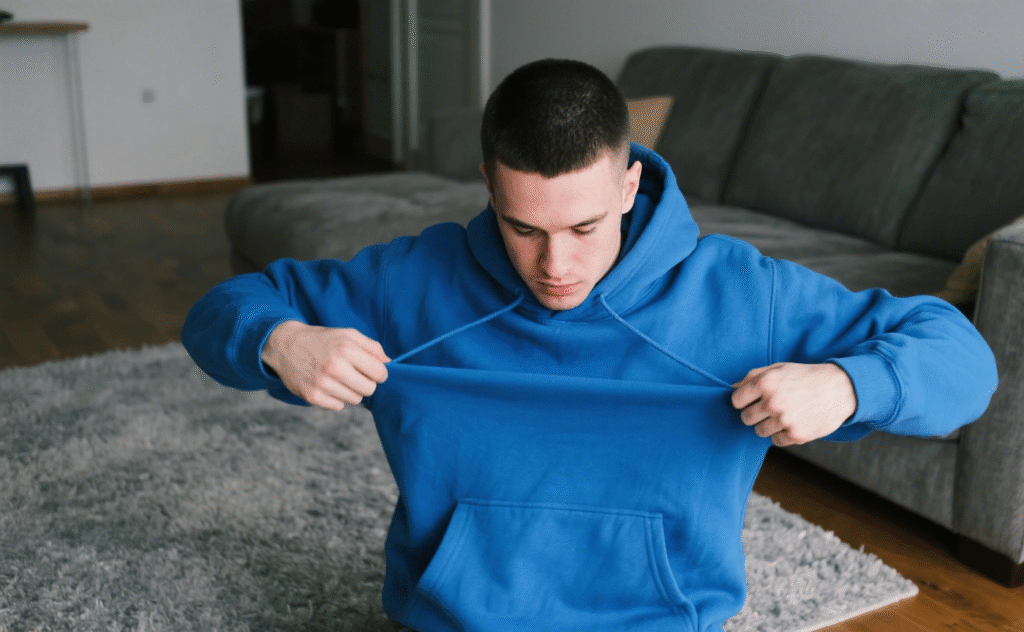
Why should you stretch a hoodie?
Stretching a hoodie is very necessary in everyday life. Your hoodie has shrunk in the laundry process. You need to stretch your hoodie to get it back to its original shape. Maybe you’ve gained weight and your hoodie’s original size is no longer comfortable for you to wear. Or maybe you want to try a looser fit hoodie. These are the problems you encounter that need to be solved by stretching a hoodie.
1. Preventing Hoodie Shrinkage
It’s all too easy to end up with a hoodie that’s a little too tight after it’s been through the wash. Many hoodies, especially those made from cotton or cotton blends, tend to shrink when exposed to hot water or high heat in the dryer. This is because the fabric fibers contract when they’re exposed to heat, causing the hoodie to lose its original shape and size.
By stretching your hoodie, you can counteract some of that shrinkage. Stretching allows you to gently return the fabric back to its original dimensions or slightly loosen it up if it’s gotten too tight. This can help maintain the hoodie’s fit and ensure you don’t have to deal with the disappointment of a snug, uncomfortable garment.
2. Gain weight. Get fat.
Because you rarely exercise, you gain weight and weigh a lot more than before. A hoodie that originally fits you well suddenly becomes tight. Stretching clothes is not only an emergency measure, but also an effective way to scientifically maintain clothes.
3. For Those Who Love a Looser Fit
A common trend in hoodie styles is the preference for a relaxed, oversized fit. Tight, form-fitting hoodies are often seen as less comfortable, and many people prefer the extra roominess that comes with a looser hoodie. If your hoodie has shrunk after washing or simply isn’t as roomy as you like, stretching it can give you that extra bit of space.
Whether you’re looking for a more relaxed look or simply want more room to move, stretching your hoodie can help you achieve the desired fit without having to buy a new one. Plus, it’s an affordable and easy way to extend the lifespan of your favorite hoodie without worrying about buying a replacement every time it shrinks a little too much.

Why Do Hoodies Shrink?
Before we dive into the stretching techniques, let’s understand why your hoodie might have shrunk in the first place. Hoodies are often made from cotton, polyester, or a cotton-blend fabric. Over time, exposure to heat—like in hot water or from a tumble dryer—can cause the fibers to tighten, resulting in shrinkage. While this might seem irreversible, stretching your hoodie can bring it back to a more comfortable size.
Common Causes of Shrinking:
- Wrong laundry cycles: Aggressive spin cycles increase stress on fabric.
- Hot water washing: Heat breaks down cotton fibers.
- High-heat drying: Causes fibers to contract.
Types of Hoodies That Shrink Easily:
- 100% Cotton Hoodies – Most prone to shrinkage.
- Fleece-lined Hoodies – Can contract when heat-dried.
- Polyester Blends – Less likely to shrink but can lose shape.
It is very common for hoodies to shrink. You don’t need to worry too much. Some people even shrink their hoodies to make them more slim-fitting. Everyone can modify their hoodies in different ways according to their actual situation to show the best personal style.

Why Baggy Hoodies Are So Popular
Baggy hoodies have evolved from a casual staple to a global fashion phenomenon, blending comfort, cultural rebellion, and self-expression. At their core, they offer a “hug you can wear” with roomy fits and soft fabrics, perfect for lounging or running errands .
Not only do baggy hoodies give off a laid-back vibe, but they’re also incredibly versatile. You can pair them with anything from fitted jeans to loose joggers, depending on the look you’re going for.
Whether styled with leggings for a casual look or layered under a tailored coat for sophistication, baggy hoodies embody the ultimate blend of comfort, versatility, and cultural cool. As TikTokers and influencers prove daily: comfort never looked so rebellious .
When buying hoodies, more people will choose the right size. Then you can stretch the hoodie in a scientific and correct way. You can get a loose hoodie. This loose size will not be too big and make you look fat. While increasing the comfort, you can wear it with other clothes to add more fashion to your casual look.
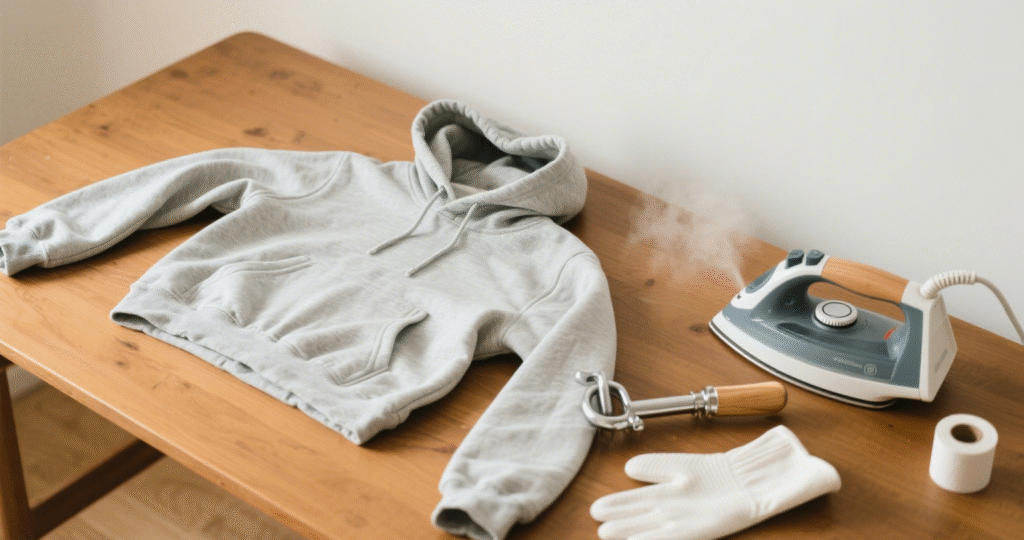
Things to Know Before Stretching Your Hoodie
Before you begin, here are a few important things to keep in mind to avoid damaging your garment and ensure the best results.
1. Check the Label First
Before attempting any stretching technique, always read the care label. This small tag gives you crucial information about your hoodie’s fabric composition—whether it’s 100% cotton, a cotton-poly blend, fleece, or another material. Natural fibers like cotton are more stretchable when wet, while synthetic fabrics may require extra care. The label also includes washing and drying guidelines, which help prevent unwanted shrinkage or damage during the process.
Pro Tip: If your hoodie is labeled “dry clean only,” avoid at-home stretching methods altogether and consult a professional.
2. Understand Your Hoodie’s Limits
Most hoodies can be safely stretched up to one to two sizes larger, depending on the fabric. However, pushing beyond that may cause irreversible damage. Cotton hoodies are generally more forgiving, while polyester blends tend to resist stretching and can easily lose shape if forced.
Remember: Always set realistic expectations. A snug hoodie can often be made more comfortable, but turning a medium into an XL overnight isn’t feasible without compromising the fabric.
3. Be Gentle and Patient
Stretching your hoodie isn’t a race. Over-pulling or using high heat can weaken the seams, warp the cuffs, or even crack printed designs. Whether you’re using water, a stretching frame, or a conditioner soak method, slow and even pressure is best.
If your hoodie has screen printing or embroidery, be extra cautious. These areas are particularly vulnerable and may not stretch uniformly with the rest of the garment.
4. Choose the Right Method
Not all hoodies respond the same way to stretching. A cotton hoodie may benefit from a warm water soak and towel-stretching method, while a synthetic blend might need a fabric softener treatment and gentle hand-stretching. The right approach will depend on what your hoodie is made of and how much stretch you’re hoping to achieve.
Stretching a hoodie is entirely possible—but only if you approach it with the right knowledge and tools. By checking the care label, understanding the fabric’s limits, and choosing a gentle technique, you can safely expand your hoodie for a more comfortable fit without sacrificing style or quality.
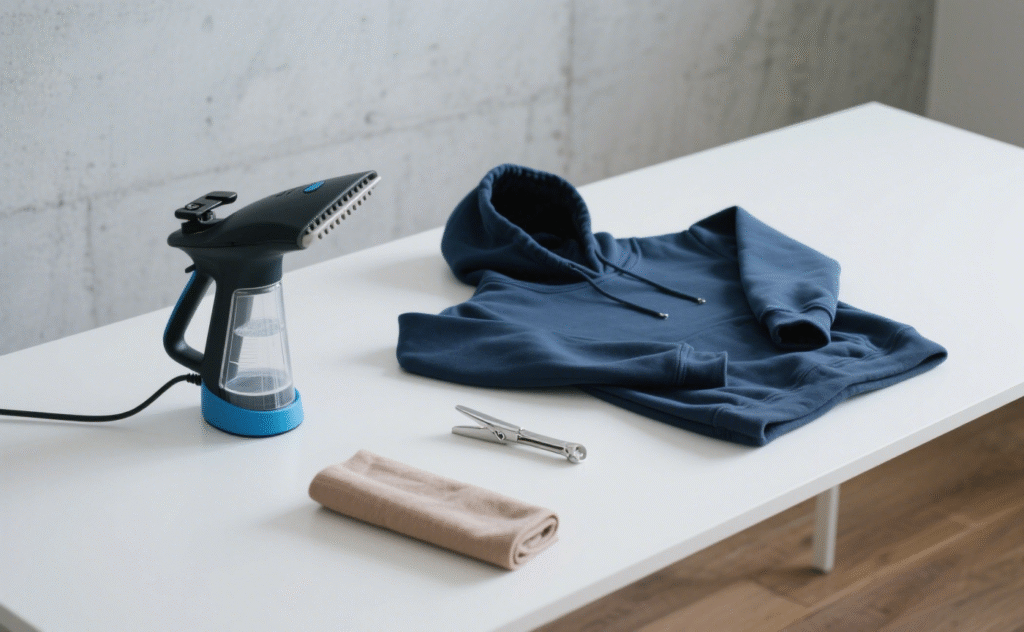
How to Stretch a Hoodie: 4 Effective Methods
There are multiple methods to stretch a hoodie, but the key is to be gentle to avoid damaging the fabric. Here are the four most common ways:
1. Warm Water and Conditioner Method (Best for Cotton and Blends)
This is one of the most popular and effective methods for stretching a hoodie. The warm water combined with conditioner helps relax the fabric fibers, making them easier to stretch without causing damage.
Step-by-Step Instructions:
- Prepare the Water: Fill a basin with lukewarm water. Add 2-3 tablespoons of hair conditioner or baby shampoo. Stir it well until it’s evenly mixed.
- Soak the Hoodie: Submerge your hoodie completely into the water and let it soak for 30 minutes. This will loosen the fabric fibers and make them easier to stretch.
- Gently Stretch the Fabric: After soaking, gently wring out the hoodie (don’t twist it). Lay the hoodie flat on a towel, then use your hands to gently pull and stretch the fabric. Focus on areas that need extra length, like the sleeves or the torso.
- Drying: Let the hoodie air dry flat on the towel. Avoid using a dryer, as it might cause the fabric to shrink again.
Pro Tips:
- Focus on specific areas that need expansion.
- Don’t stretch too aggressively; moderate pressure gives best results.
Why It Works: The conditioner or shampoo helps soften the fibers, making the hoodie more pliable. This method works best for cotton, cotton-blend, or polyester hoodies.

2. Steam and Iron Method (For Polyester and Cotton Blends)
Steam can help gently loosen tight fabric fibers. Making them more pliable for stretching. This method works well for hoodies made from synthetic fabrics like polyester, which tend to respond well to heat.
Step-by-Step Instructions:
- Prepare the Hoodie: Hang the hoodie on a clothes hanger or lay it flat on a towel.
- Steam the Fabric: Using a handheld steamer or steam iron (with steam function), gently steam the fabric, focusing on areas that feel tight.
- Stretch the Fabric: As the fabric heats up, gently pull and stretch it by hand. Apply gentle pressure to areas like the sleeves, waist, or hood.
- Let It Dry: Once the desired stretch is achieved, allow the hoodie to air dry naturally.
Tip: Repeat once or twice for better results.
Caution: Don’t overstretch synthetic fibers—they can lose their structure.
Why It Works: The heat from the steam relaxes the fibers in the fabric, making it easier to pull and stretch the hoodie without damaging it.
3. Wear-to-Stretch Method (Best for Casual Use)
If you’re looking for a low-effort solution, the wear-to-stretch method allows you to stretch your hoodie naturally. This method uses your body to help reshape the hoodie. This is especially effective for cotton and cotton-blend fabrics.
Step-by-Step Instructions:
- Soak the Hoodie: Soak the hoodie in lukewarm water. After about 10-15 minutes, wring out the excess water.
- Wear the Hoodie: Put on the damp hoodie while it’s still wet. The heat from your body will help stretch the fabric as it dries.
- Let It Dry: Leave the hoodie on while it dries or let it air dry naturally while you continue wearing it.
Note: Don’t attempt this method in a cold room. Stay warm and safe!
Why It Works: This method uses your body’s natural warmth to help stretch the fabric without needing extra tools or chemicals. The fibers reshape to your body movements, giving you a perfect fit—especially around arms and chest.

4. Heavy Object Method (For Significant Stretching)
For those who need a more dramatic size change (like if your hoodie shrunk too much in the dryer), you can use a heavy object to stretch it out. This method is effective but requires patience. This works well when you want to target specific sections.
Step-by-Step Instructions:
- Soak the Hoodie: Soak the hoodie in lukewarm water (using the same method as the first technique).
- Stretch the Fabric: Lay the hoodie flat and use your hands to gently stretch it. Focus on areas like the torso and sleeves.
- Place a Heavy Object: Once the hoodie is stretched to your satisfaction, place a heavy object on the stretched areas to hold them in place. Leave it like this for 24-48 hours.
- Let It Dry: Once the hoodie is dry, remove the heavy object and enjoy your newly stretched hoodie.
Why It Works: The weight helps keep the fabric stretched as it dries, preventing it from shrinking back.
Considerations:
- Fabric Type Matters: Not all fabrics stretch the same way. Cotton and cotton-blends tend to stretch more easily than synthetic fabrics like polyester.
- Don’t Overstretch: Be careful not to pull too hard. Overstretching can weaken the fibers and cause irreversible damage.
- Test a Small Area First: If you’re unsure about the fabric’s reaction, test the stretching method on a small, inconspicuous area first.
More Tips for Hoodie Stretching:
1. Using a Stretching Solution: Some specialty stretching solutions are available in the market. Apply the solution to the tight areas of the hoodie and gently stretch the fabric. Follow the manufacturer’s instructions for the best results.
2. You can purchase a hoodie stretcher or stretch frame. Using a dedicated garment stretcher can help maintain or increase the size of your hoodie without losing its shape.
3. If you are short on time. If your hoodie is a limited edition. Then you can find a hoodie service provider. They have more professional equipment skills. Experienced staff. They can help you solve all the problems of hoodie stretching. Just pay a little money, and you can give your hoodie a new life.
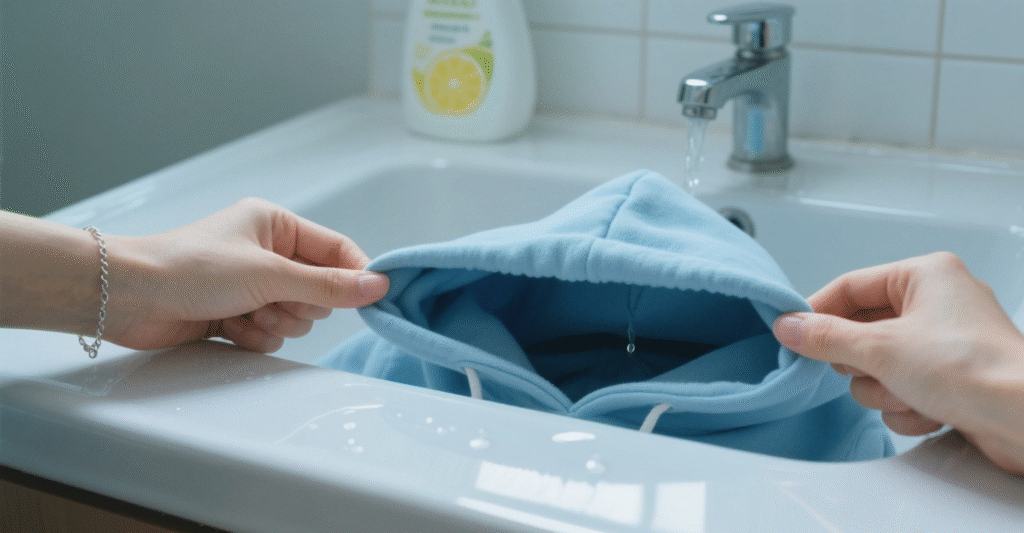
Targeted Stretching: Adjust Specific Areas
Sometimes only certain parts of your hoodie need more room.
Stretching Sleeves
- Insert rolls or bottles inside while damp.
- Tug gently outward and downward.
- Steam around the cuffs and pull in circular motion to loosen ribbing.
Expanding Torso or Waistband
- Stretch out side seams widthwise.
- Use weights or clips to anchor while drying for consistent shape.
Enlarging the Hood
- Stuff with towel roll or hoodie shaper.
- Steam internal seams before stretching to widen opening.
Comparison Table: Hoodie Stretching Techniques
| Method | Time Required | Risk Level | Best For | Tools Needed |
|---|---|---|---|---|
| Conditioner Soak | 45–60 min | Low | Overall stretch | Conditioner, towel |
| Manual Warm Stretch | ~30 min | Low | Width, length, sleeves | Hands, water, towel |
| Steam Stretching | 15–20 min | Moderate | Precise problem spots | Steamer or iron |
| Wear-to-Stretch | Sessions over time | Very Low | Natural body-fit shaping | Body heat, time |
The Science Behind Stretching Hoodies
- Moisture and fiber bonds: Conditioner and warm water temporarily break hydrogen bonds in fibers.
- Heat and fiber memory: Steam relaxes structured fibers, allowing them to reset when cooled in new shape.
- When it fails: Polyester-heavy or pre-shrunk fabrics often resist permanent stretching due to synthetic memory retention.

How to Care for Your Hoodie After Stretching
After successfully stretching out your hoodie, it’s essential to maintain its stretched shape. It would be a shame if it shrinks again the next time you wash it! Follow these tips to keep your hoodie in its desired fit:
Wash your hoodie according to the clothing manufacturer’s instructions
Always refer to the care label before washing your hoodie. Manufacturers include specific guidelines based on the fabric composition and construction. Washing your hoodie incorrectly could lead to shrinkage or fabric damage, undoing your stretching efforts.
Use Cold Water to Prevent Fiber Contraction
Washing your stretched hoodie in cold water is essential to maintain its new size. Hot water can cause the fibers to contract, potentially making your hoodie shrink back to its original fit.
Avoid High-Heat Drying – Air Dry Instead
Heat is the enemy of stretched fabric. Drying your hoodie in a high-heat setting can quickly reverse the stretching process. Instead, opt for air drying by laying the hoodie flat on a clean towel or hanging it in a well-ventilated area.
Store Properly to Maintain Shape
Storing your hoodie the right way can help maintain its stretched shape. Fold it neatly and place it in a drawer or on a shelf instead of hanging it on a hanger, which can cause distortion in the shoulders or neckline.
Choose a high-quality hoodie that resists shrinkage. Like this organic cotton and bamboo blend hoodie from Sumk Clothing. It can effectively reduce maintenance costs. And Sumk Clothing provides a 1-year hoodie quality assurance service.
Remember, proper care is just as important as the stretching process itself. By following these hoodie care tips, you can extend the life of your stretch hoodie and keep it in ideal shape.
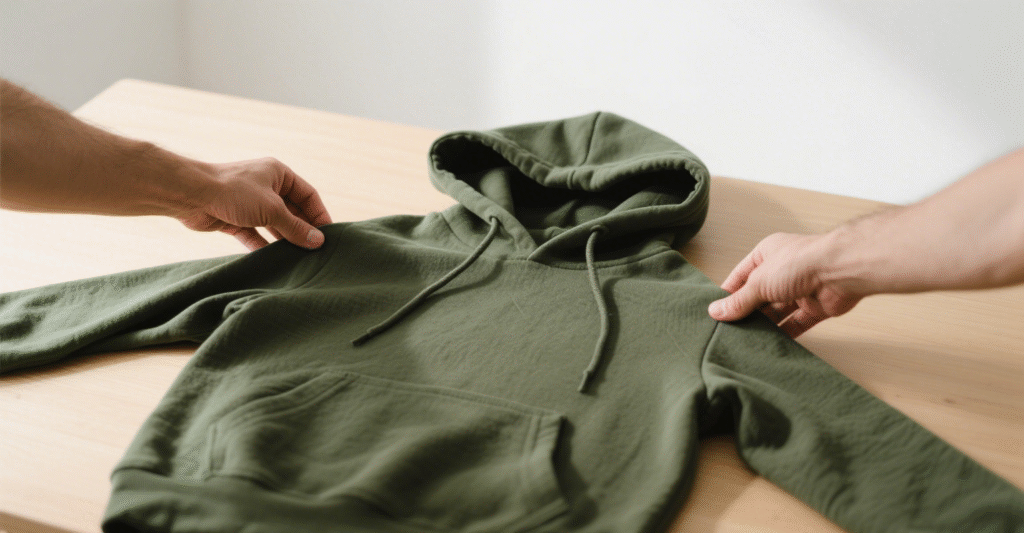
Common Mistakes to Avoid When Stretching Your Hoodie
Stretching your hoodie incorrectly can cause your hoodie to lose its shape. Here are some common mistakes to avoid that will keep your hoodie from looking stylish and chic:
1. Sizing Up Too Much
While going up a size might seem like the easiest way to get that cozy, oversized fit, sizing up excessively can backfire. An overly large hoodie can lose its original silhouette, leading to a look that’s more sloppy than stylish. Instead, opt for just one size up and stretch moderately to achieve a natural drape without compromising the hoodie’s structure.
2. Overstretching the Fabric
It’s tempting to tug hard on your hoodie to get that baggy fit, but overstretching can permanently damage the fabric fibers. This not only weakens the material but can also lead to sagging sleeves and a droopy neckline. To preserve longevity, stretch slowly and evenly—preferably after warming up the fabric slightly with steam or a warm wash.
3. Ignoring Proportions in Styling
Even if you achieve the perfect oversized fit, poor styling can throw off the whole look. Avoid pairing a baggy hoodie with loose bottoms unless you’re intentionally going for a streetwear vibe. For a more balanced appearance, style your stretched hoodie with fitted jeans, leggings, or structured pieces to create contrast and visual interest.
Frequently Asked Questions (FAQs)
Yes, you can stretch a hoodie slightly bigger. Soak it in lukewarm water with hair conditioner for 20–30 minutes. Then gently pull the fabric while it’s damp, focusing on tight areas like sleeves or chest. Lay flat to air dry—avoid using heat, which may shrink it again.
To loosen a hoodie, soak it in warm water with conditioner, then stretch it gently by hand. Focus on key areas like the body, arms, or waistband. Lay it flat while drying to hold the new shape. Repeat the process if needed for better results.
If your hoodie is too big, try shrinking it by washing in hot water and tumble drying. Or have it professionally tailored. You can also embrace the oversized look or layer it over thicker clothes for better fit and style.
If your hoodie is too big, try shrinking it by washing in hot water and tumble drying. Or have it professionally tailored. You can also embrace the oversized look or layer it over thicker clothes for better fit and style.
Yes, it may respond to a conditioner soak, but results vary depending on fabric type.
If not cared for properly, yes. Cold-wash and air-dry every time.
Only if the design isn’t tight-knit—test a small section first.
Yes, but take care to avoid overheating that may damage the inner surface.




